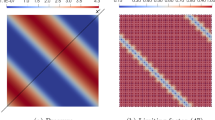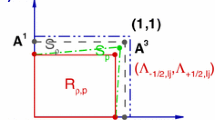Abstract
We introduce a general framework for enforcing local or global maximum principles in high-order space-time discretizations of a scalar hyperbolic conservation law. We begin with sufficient conditions for a space discretization to be bound preserving (BP) and satisfy a semi-discrete maximum principle. Next, we propose a global monolithic convex (GMC) flux limiter which has the structure of a flux-corrected transport (FCT) algorithm but is applicable to spatial semi-discretizations and ensures the BP property of the fully discrete scheme for strong stability preserving (SSP) Runge–Kutta time discretizations. To circumvent the order barrier for SSP time integrators, we constrain the intermediate stages and/or the final stage of a general high-order RK method using GMC-type limiters. In this work, our theoretical and numerical studies are restricted to explicit schemes which are provably BP for sufficiently small time steps. The new GMC limiting framework offers the possibility of relaxing the bounds of inequality constraints to achieve higher accuracy at the cost of more stringent time step restrictions. The ability of the presented limiters to recognize undershoots/overshoots, as well as smooth solutions, is verified numerically for three representative RK methods combined with weighted essentially nonoscillatory (WENO) finite volume space discretizations of linear and nonlinear test problems in 1D. In this context, we enforce global bounds and prove preservation of accuracy for the linear advection equation.




Similar content being viewed by others
Data Availability
The code to reproduce the datasets (in all tables) is available at https://github.com/manuel-quezada/BP_Lim_for_RK_Methods.
References
Boris, J.P., Book, D.L.: Flux-corrected transport: I. SHASTA, a fluid transport algorithm that works. J. Comput. Phys. 11, 38–69 (1973)
Zalesak, S.T.: Fully multidimensional flux-corrected transport algorithms for fluids. J. Comput. Phys. 31, 335–362 (1979)
Harten, A.: High resolution schemes for hyperbolic conservation laws. J. Comput. Phys. 49, 357–393 (1983)
Harten, A.: On a class of high resolution total-variation-stable finite-difference-schemes. SIAM J. Numer. Anal. 21, 1–23 (1984)
Gottlieb, S., Ketcheson, D., Shu, C.-W.: Strong Stability Preserving Runge-Kutta and Multistep Time Discretizations. World Scientific, Singapore (2011)
Gottlieb, S., Shu, C.-W., Tadmor, E.: Strong stability-preserving high-order time discretization methods. SIAM Rev. 43, 89–112 (2001)
Zhang, X., Shu, C.-W.: Maximum-principle-satisfying and positivity-preserving high-order schemes for conservation laws: survey and new developments. Proc. Royal Soc. A: Math. Phys. Eng. Sci. 467, 2752–2776 (2011)
Hundsdorfer, W., Ketcheson, D.I., Savostianov, I.: Error analysis of explicit partitioned Runge–Kutta schemes for conservation laws. J. Sci. Comput. 63, 633–653 (2015)
Ketcheson, D.I., MacDonald, C.B., Ruuth, S.J.: Spatially partitioned embedded Runge–Kutta methods. SIAM J. Numer. Anal. 51, 2887–2910 (2013)
Kuzmin, D., Quezada de Luna, M., Kees, C.: A partition of unity approach to adaptivity and limiting in continuous finite element methods. Computers Math. Appl. 78, 944–957 (2019)
Arbogast, T., Huang, C.-S., Zhao, X., King, D.N.: A third order, implicit, finite volume, adaptive Runge-Kutta WENO scheme for advection-diffusion equations. Computer Methods Appl. Mech. Engrg. 368, 113155 (2020)
Duraisamy, K., Baeder, K., Liu, J.-G.: Concepts and application of time-limiters to high resolution schemes. J. of Sci. Comput. 19, 139–162 (2003)
Feng, D., Neuweiler, I., Nackenhorst, U., Wick, T.: A time-space flux-corrected transport finite element formulation for solving multi-dimensional advection-diffusion-reaction equations. J. Comput. Phys. 396, 31–53 (2019)
Lee, J.-L., Bleck, R., MacDonald, A.E.: A multistep flux-corrected transport scheme. J. Comput. Phys. 229, 9284–9298 (2010)
Lohmann, C., Kuzmin, D., Shadid, J.N., Mabuza, S.: Flux-corrected transport algorithms for continuous Galerkin methods based on high order Bernstein finite elements. J. Comput. Phys. 344, 151–186 (2017)
Xiong, T., Qiu, J.-M., Zhengfu, X.: High order maximum-principle-preserving discontinuous Galerkin method for convection-diffusion equations. SIAM J. Sci. Comput. 37(2), A583–A608 (2015)
Yang, P., Xiong, T., Qiu, J.-M., Zhengfu, X.: High order maximum principle preserving finite volume method for convection-dominated problems. J. of Sci. Comput. 67(2), 795–820 (2016)
Xiong, T., Qiu, J.M., Xu, Z.: A parametrized maximum principle preserving flux limiter for finite difference RK-WENO schemes with applications in incompressible flows. J. Comput. Phys. 252, 310–331 (2013)
Zhengfu, X.: Parametrized maximum principle preserving flux limiters for high order schemes solving hyperbolic conservation laws: one-dimensional scalar problem. Math. Comput. 83–289, 2213–2238 (2014)
Kuzmin, D.: Monolithic convex limiting for continuous finite element discretizations of hyperbolic conservation laws. Comput. Methods Appl. Mech. Engrg. 361, 112804 (2020)
Anderson, R., Dobrev, V., Kolev, T., Kuzmin, D., Quezada de Luna, M., Rieben, R., Tomov, V.: High-order local maximum principle preserving (MPP) discontinuous Galerkin finite element method for the transport equation. J. Comput. Phys. 334, 102–124 (2017)
Hajduk, H.: Monolithic convex limiting in discontinuous Galerkin discretizations of hyperbolic conservation laws. Preprint arXiv:2007.01212 [math.NA] (2020)
Kuzmin, D., Hajduk, H., Rupp, A.: Limiter-based entropy stabilization of semi-discrete and fully discrete schemes for nonlinear hyperbolic problems. Preprint arXiv:2107.11283 [math.NA], July (2021)
Kuzmin, D., Quezada de Luna, M.: Entropy conservation property and entropy stabilization of high-order continuous Galerkin approximations to scalar conservation laws. Computers Fluids 213, 104742 (2020)
LeVeque, R.J.: Finite Volume Methods for Hyperbolic Problems. Cambridge University Press, Cambridge (2002)
Guermond, J.-L., Popov, B.: Invariant domains and first-order continuous finite element approximation for hyperbolic systems. SIAM J. Numer. Anal. 54, 2466–2489 (2016)
Hu, X.Y., Adams, N.A., Shu, C.-W.: Positivity-preserving method for high-order conservative schemes solving compressible Euler equations. J. Comput. Phys. 242, 169–180 (2013)
Zhang, X., Shu, C.-W.: On positivity-preserving high order discontinuous Galerkin schemes for compressible Euler equations on rectangular meshes. J. Comput. Phys. 229, 8918–8934 (2010)
Deimling, K.: Ordinary Differential Equations in Banach Spaces, vol. 596. Springer, Berlin (2006)
Blanchini, F.: Set invariance in control. Automatica 35(11), 1747–1767 (1999)
Horváth, Z.: Invariant cones and polyhedra for dynamical systems. In: In Proceeding of the International Conference in Memoriam Gyula Farkas, pp. 65–74 (2005)
Jameson, A.: Computational algorithms for aerodynamic analysis and design. Appl. Numer. Math. 13, 383–422 (1993)
Jameson, A.: Positive schemes and shock modelling for compressible flows. Int. J. Numer. Methods Fluids 20, 743–776 (1995)
Cotter, C.J., Kuzmin, D.: Embedded discontinuous Galerkin transport schemes with localised limiters. J. Comput. Phys. 311, 363–373 (2016)
Guermond, J.-L., Nazarov, M., Popov, B., Tomas, I.: Second-order invariant domain preserving approximation of the Euler equations using convex limiting. SIAM J. Sci. Comput. 40, A3211–A3239 (2018)
Kuzmin, D.: A new perspective on flux and slope limiting in discontinuous Galerkin methods for hyperbolic conservation laws. Comput. Methods Appl. Mech. Engrg. 373, 113569 (2021)
Hairer, E., Norsett, S.P., Wanner, G.: Solving Ordinary Differential Equations I: Nonstiff Problems, 2nd edn. Springer, Berlin (1993)
Barth, T., Jespersen, D.C.: The design and application of upwind schemes on unstructured meshes. AIAA Paper, 89-0366 (1989)
Shu, C.-W.: High order weighted essentially nonoscillatory schemes for convection dominated problems. SIAM Rev. 51, 82–126 (2009)
Guermond, J.-L., Pasquetti, R., Popov, B.: Entropy viscosity method for nonlinear conservation laws. J. Comput. Phys. 230, 4248–4267 (2011)
Kurganov, A., Tadmor, E.: New high-resolution central schemes for nonlinear conservation laws and convection-diffusion equations. J. Comput. Phys. 160, 241–282 (2000)
Kurganov, A., Petrova, G., Popov, B.: Adaptive semidiscrete central-upwind schemes for nonconvex hyperbolic conservation laws. SIAM J. Sci. Comput. 29, 2381–2401 (2007)
Ern, A., Guermond, J.-L.: Weighting the edge stabilization. SIAM J. Numer. Anal. 51, 1655–1677 (2013)
Kuzmin, D.: Entropy stabilization and property-preserving limiters for \(P_1\) discontinuous Galerkin discretizations of scalar hyperbolic problems. J. Numer. Math. (2020). https://doi.org/10.1515/jnma-2020-0056
Kuzmin, D., Quezada de Luna, M.: Algebraic entropy fixes and convex limiting for continuous finite element discretizations of scalar hyperbolic conservation laws. Comput. Methods Appl. Mech. Engrg. 372, 113370 (2020)
Lohmann, C.: Physics-Compatible Finite Element Methods for Scalar and Tensorial Advection Problems. Springer Spektrum, Berlin (2019)
Kraaijevanger, J.F.B.M.: Contractivity of Runge–Kutta methods. BIT 31, 482–528 (1991)
Spiteri, R.J., Ruuth, S.J.: A new class of optimal high-order strong stability-preserving time discretization methods. SIAM J. Numer. Anal. 40, 469–491 (2002)
Butcher, J.C.: On Runge–Kutta processes of high order. J. Australian Math. Soc. 4–2, 179–194 (1964)
Funding
The work of Dmitri Kuzmin and Johanna Grüll was supported by the German Research Association (DFG) under Grant KU 1530/23-1. The work of Manuel Quezada de Luna and David I. Ketcheson was funded by King Abdullah University of Science and Technology (KAUST) in Thuwal, Saudi Arabia.
Author information
Authors and Affiliations
Corresponding author
Ethics declarations
Conflict of interest
The authors declare that they have no known conflicts of interest, competing interests or personal relationships that could have appeared to influence the work reported in this paper.
Code Availability
The code to reproduce the numerical experiments is available at https://github.com/manuel-quezada/BP_Lim_for_RK_Methods.
Additional information
Publisher's Note
Springer Nature remains neutral with regard to jurisdictional claims in published maps and institutional affiliations.
Appendix A. High-Order Baseline RK Methods
Appendix A. High-Order Baseline RK Methods
In this appendix, we provide details of the three high-order explicit baseline RK methods for solving
1.1 Appendix A.1. Fourth-Order Strong Stability Preserving (SSP54) RK Method
The SSP-RK time integrator that we consider in this work is the 4th-order method proposed in [47, 48]. The Butcher form of its intermediate stages is as follows:
Note that each stage is a convex combination of Euler steps. Therefore, if \(F(\cdot )\) is a BP spatial discretization and \(u^n\) is BP, then each stage is BP under appropriate time step restrictions. The RK update is given by \(u^{n+1} = y^{(5)}\). Hence, if the stages are BP, \(u^{n+1}\) is BP and no extra limiting is needed.
1.2 Appendix A.2. Fifth-Order Extrapolated Euler (ExE-RK5) RK Method
The Butcher tableau of the 5th-order extrapolated Euler RK method is given by
The intermediate stages (written in Shu-Osher and Butcher form) are as follows:
Note that if \(F(\cdot )\) is a BP spatial discretization and \( u^n\) is BP, then each stage of this ExE-RK method is BP under appropriate time step restrictions. The approximations \(y^{(1)}\), \(y^{(2)}\), \(y^{(3)}\), \(y^{(5)}\), and \(y^{(8)}\) are BP because they correspond to forward Euler updates of \(u^n\). The remaining stages are BP since \(y^{(m)}\) is a forward Euler update of a BP approximation \(y^{(r)}\) for some \(r\in \{1,\ldots ,m-1\}\).
The Aitken–Neville interpolation yields the temporally 5th-order approximation
Note that this Euler extrapolation method combines \(S=5\) first-order approximations of \(u^{n+1}\). Since this combination is not convex, \(u^\mathrm{RK}\) is not necessarily BP even if \(y^{(1)},\ldots ,y^{(11)}\) are BP. To enforce the BP property of the final solution, we perform flux limiting using the Butcher form representation
1.3 Appendix A.3. Sixth-Order (RK76) RK Method
This 6th-order RK method, proposed in [49], consists of seven stages and has the Butcher tableau
The intermediate stages of this method are not Euler steps. If we require them to be BP, the numerical fluxes \(H_{ij}\) should be constrained using the limiters from Sect. 3.3 in each stage. The BP property of the final solution \(u^\mathrm{RK}\) can be enforced similarly using the limiter from Sect. 3.2.
Rights and permissions
About this article
Cite this article
Kuzmin, D., Quezada de Luna, M., Ketcheson, D.I. et al. Bound-preserving Flux Limiting for High-Order Explicit Runge–Kutta Time Discretizations of Hyperbolic Conservation Laws. J Sci Comput 91, 21 (2022). https://doi.org/10.1007/s10915-022-01784-0
Received:
Revised:
Accepted:
Published:
DOI: https://doi.org/10.1007/s10915-022-01784-0




